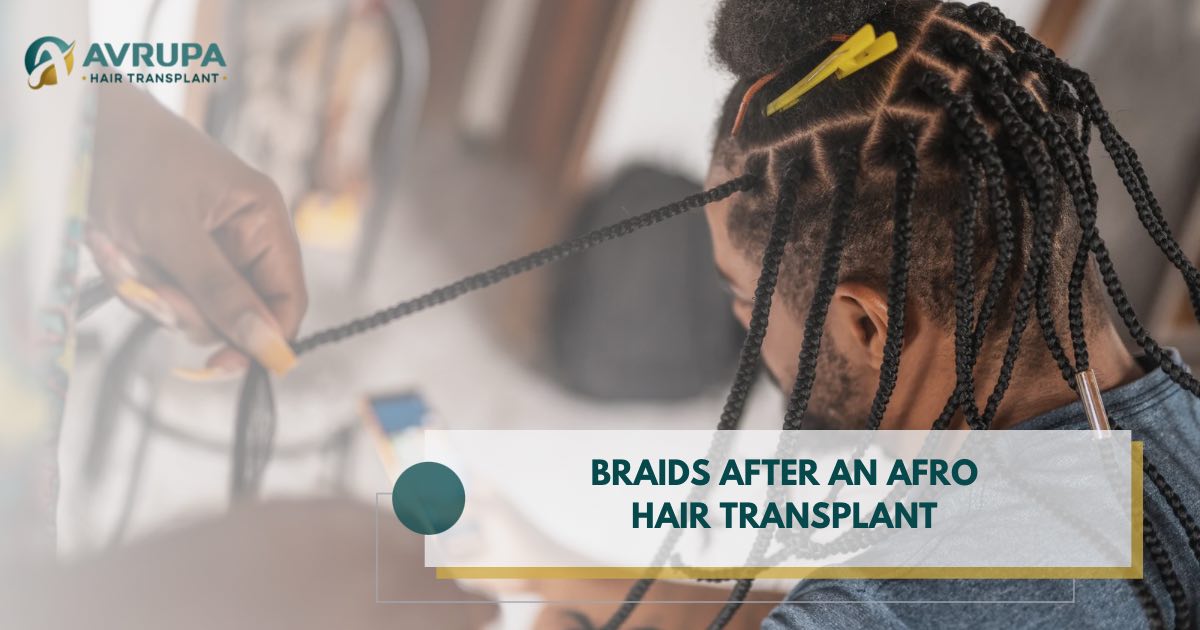Avoid any braiding or retwisting until well after the grafts have safely anchored and early healing is complete. Transplanted grafts are generally no longer dislodged by around day 10-14 (especially if crusts are well managed), but braids create traction, so most patients should wait at least 6–8 weeks before attempting very loose, partial braids—and only with the surgeon’s approval.
Patients who wish to do tighter, edge-focused styles (cornrows, micro-braids, feed-ins) should wait a little longer for a few months. Your exact timeline is individualized.
Why the Timing Matters (Biology + Biomechanics)
- Graft anchoring: Transplanted follicles are held in place by fibrin early on; with normal healing, they become secure by roughly day 10-14. Crusting can prolong risk, which is why surgeons emphasize gentle washing and crust management.
- Traction is the enemy: Braids and other tight styles load follicles with constant tension. In susceptible patients, that tension can lead to traction alopecia—and recently transplanted follicles are the most vulnerable. Dermatology guidance is clear: avoid tight, pulling styles.
Protective styling after a transplant must be avoided for a certain period of time. Our team provides Afro hair patients with detailed timelines to safely reintroduce braids, twists, or locs, so results stay permanent, and edges stay strong.
The phased braiding timeline (Afro-textured hair)
The schedule below blends what we know about graft security with the medical guidance on traction. Always defer to your surgeon’s specific protocol.
Days 0–14: Protect the transplanted hair
- No braiding, retwisting, or headwear that touches grafts. Follow your clinic’s wash protocol; keep friction minimal. (Many surgeons allow only gentle rinsing/misting in this window.)
Days 3–14: Crusts lift, but grafts still vulnerable
- Continue gentle washing as instructed to remove crusts without picking.
- No braids, retwists, grips, scarves that rub, or tight caps yet.
- Rationale: classic graft-anchoring work shows grafts are no longer at risk of being dislodged at day 10-14 when crusting is minimized.
Days 10–14: Grafts secure but traction still off-limits
- Most patients can resume normal shampooing around day 10-14; light, hands-off grooming is OK. Still avoid any traction.
Weeks 3–4: Hands-off styling only
- You can wear hair loosely (e.g., down, soft wraps that don’t touch grafts).
- Skip protective styles that pinch edges or load tension across the hairline/temples.
- Why: traction alopecia risk is cumulative—give follicles time to fully integrate.
Weeks 6–8: Consider very loose, partial braids (surgeon clearance)
- If healing is uncomplicated, discuss trying large, loose braids away from the most heavily grafted zones.
- Rules: oversized parts, zero pain, no tight knots, no rubber-band strangling at the base, minimal weight. Stop immediately if you feel ache/itch along parts or see perifollicular bumps (early traction signs).
Weeks 8–12: Gradual return to protective styling
- Expand braid patterns gradually while keeping tension minimal, especially at the edges.
- Avoid added hair that dramatically increases weight over recipient areas. Traction guidance still applies.
3–4 months and beyond: Regrowth phase
- Early regrowth starts; you can increase styling freedom—but keep edge work gentle.
- Final cosmetic density continues to build to 12–18 months.
Special Situations You Must Rule Out First
1) Traction alopecia history
If braids or locs contributed to your hair loss, treat traction as an ongoing risk factor. Even after a perfect transplant, tight styling can undo results. Dermatology organizations advise stopping tight hairstyles and switching to low-risk alternatives.
2) CCCA (Central Centrifugal Cicatricial Alopecia)
In some women of African descent, CCCA—a scarring alopecia—can mimic or coexist with traction loss. If suspected, your dermatologist may recommend a scalp biopsy and medical treatment before surgery; operating on active scarring disease risks loss of native and transplanted hairs.
3) Keloid or hypertrophic scar tendency
Keloids are uncommon after FUE but documented; disclose any personal/family history. Your team may use test incisions and scar-minimizing protocols, and may adjust your styling timeline longer to reduce mechanical stress over healing sites.
What Counts as a Braid (Risk Ranked from Gentlest to Riskiest)
- Loose, oversized braids/plaits (low tension, large parts, no added hair) → earliest option post-clearance.
- Box braids / knotless braids (can be gentle if large and light but often add weight).
- Cornrows / feed-ins / micro braids (highest edge tension; postpone longest).
- Added hair/heavy extensions (increase traction; avoid over recipient zones until you have months of healing under your belt).
Zero pain rule: if it hurts during or after styling, it’s too tight—this is a standard red flag for traction risk.
FAQs
Can I do “knotless” braids earlier since they’re lighter?
“Knotless” usually reduces base bulk, but timing still depends on tension and weight. Start no earlier than 6–8 weeks with large, very loose sections—only if your surgeon agrees.
Can I get cornrows after a hair transplant?
